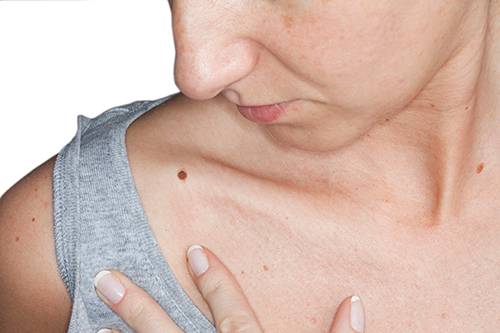Specific Enzymes Cause Mutations That Fuel Aggressive Skin Cancer in Patients With RDEB, Study Shows

A family of enzymes with genome-editing function to enhance immune system responses are driving the high rate of skin cancer in patients with recessive dystrophic epidermolysis bullosa (RDEB), a new study shows.
The study also reports that the type of mutations present in RDEB skin tumors are closer to those of patients with neck and head cancers, and farther from those with skin cancer due to prolonged and unprotected sun light exposure. These findings suggest that therapies approved for head and neck cancers also may prove effective against RDEB skin cancer.
The study “APOBEC mutation drives early-onset squamous cell carcinomas in recessive dystrophic epidermolysis bullosa” was published in the journal Science Translational Medicine.
People with RDEB, an inherited, rare, blistering skin disease, have a higher risk for developing aggressive squamous cell carcinoma, the second-most common form of skin cancer, early in life. This cancer also can affect the mouth, lungs and cervix, which is the lowest region of the uterus.
Prolonged sun exposure is usually the cause for developing this type of cancer in non-RDEB patients but, if detected early, the cancer is curable. In contrast, in RDEB patients this type of cancer is extremely aggressive with a five-year survival rate close to zero.
The molecular mechanism underlying RDEB patients higher prevalence for skin cancer, which arises in areas of sustained tissue damage, and why it is so aggressive is unknown.
To shed light on this question, a team led by researchers at the Sidney Kimmel Cancer Center – Jefferson Health collected samples from RDEB patients with squamous cell carcinoma from all around the world, including the Jefferson’s clinic for Adult EB patients, one of the few clinics offering treatment for cancer in RDEB patients.
They performed a detailed molecular analysis using sequencing techniques of 27 RDEB squamous cell carcinoma tumors isolated from RDEB patients. The samples included multiple tumors from the same patient and from multiple tumor regions.
Researchers compared their results with published data from 38 spontaneous, ultraviolet (UV) light–induced cutaneous squamous cell carcinoma, and 279 head and neck squamous cell carcinomas.
The analysis revealed that the mutations in RDEB patients’ tumors, by large, were caused by the action of a group of enzymes called apolipoprotein B editing complex (APOBEC).
APOBEC enzymes edit our DNA and DNA messages (encoded as messenger RNA molecules) to enhance, for example, our immune system’s panoply of antibody-fighting molecules. These enzymes also can edit the genome of pathogens, like those of viruses, to restrict their ability to infect.
In RDEB patients, the levels of APOBEC enzymes is high due to tissue damage and a persistent threat for infection. As a consequence of their hyperactivity, the enzymes may attack patients’ DNA, leading to cancer-causing mutations.
“We’re describing for the first time a mechanism that instigates tissue damage-driven cancers,” Andrew South, PhD, associate professor in the department of Dermatology and Cutaneous Biology at Jefferson, and the study’s senior author, said in a press release.
The mutational burden due to APOBEC enzymes accounted for 42 percent of the mutations in the RDEB skin tumors analyzed; a clear contrast to the fewer than 2 percent found in most people with skin cancer, namely those with sunlight (UV)-induced squamous cell carcinoma.
Overall, the results suggest that APOBEC alterations clearly distinguish skin cancer of RDEB patients from those caused by sunlight exposure. Researchers also found that the mutation rate due to APOBECs is accelerated in RDEB patients, i.e., that mutations associated with this process increase with time in these patients.
The team believes that the chronic damage and inflammation associated with RDEB may contribute to the spur of cancer-linked mutations.
“We show for the first time that a different mutational process appears to promote cancers caused by chronic tissue damage, as observed in RDEB. This is potentially an invisible force that also contributes to a much broader range of cancers,” said Raymond Cho, MD, PhD, associate professor in the Department of Dermatology at University of California, San Francisco (UCSF), and the study’s first author.
In their analysis, the researchers also found that tumors of RDEB patients are more similar to head and neck squamous cell carcinoma tumors, than those developed due to prolonged sunlight exposure.
These findings are in agreement with previous data showing that head and neck SCC tumors are more aggressive than sunlight-linked skin tumors, and also carry a higher burden of APOBEC-driven mutations.
Most importantly, the results suggest that therapies used in head and neck cancers may be effective for RDEB skin cancers.
One of the FDA approved therapies for head and neck cancers is Opdivo (nivolumab, developed by Bristol-Myers Squibb), which, in light of these new findings, also may work against RDEB skin cancer.
The U.S. Department of Defense recently awarded a grant of almost $1.75 million to South to investigate what turns on APOBEC enzymes, and to develop inhibitors of their activity.
“Such inhibitors could be used to help prevent mutation acquisition and skin cancer development in RDEB patients,” said South.
This work was funded by Cure EB (previously known as The Sohana Research Fund), EB Research Partnership, and by grants from Debra International and the National Cancer Institute.






